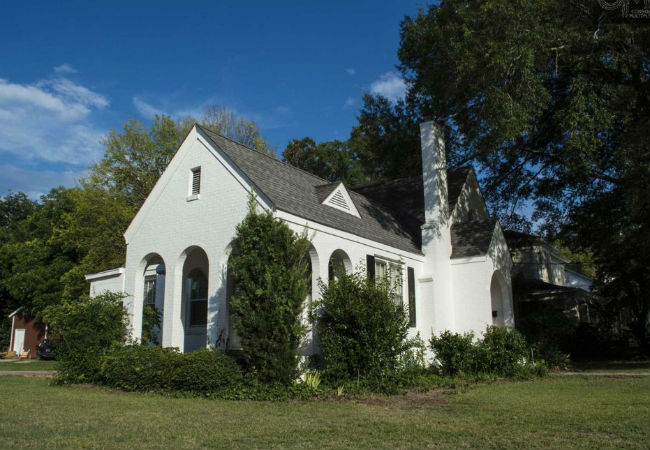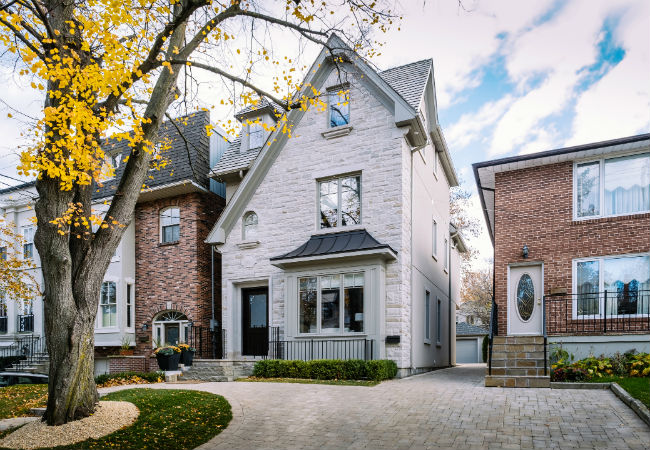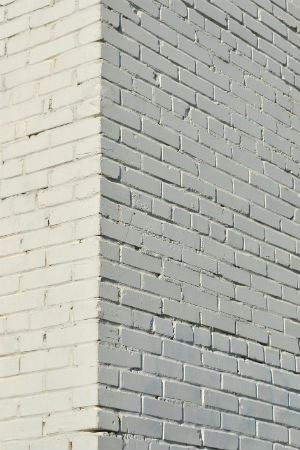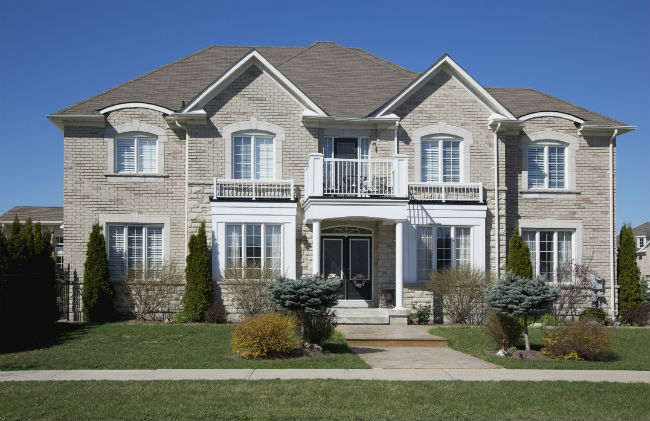We may earn revenue from the products available on this page and participate in affiliate programs. Learn More ›
Despite being one of the most durable materials around, brick very visibly ages. Its crisp square edges can soften, and joint repairs on brick siding can leave noticeable imperfections. Even if your brick remains in great shape, the color or shade of the building blocks may now make your house look drab and dated (remember the orange bricks of the ’80s?). Before you grab a bucket of paint to cover any of these blemishes, consider the benefits of an alternative, time-honored coating: limewash.
This application produces a soft white façade that improves your home’s curb appeal while adding a measure of protection against the elements. Unlike some types of brick updates—such as tuckpointing or repointing, which should be done by professionals—limewashing is an accessible project for do-it-yourselfers and inexpensive to boot! If you’re thinking about changing the look of your bricks, keep reading. We’ll run through the basics of limewashed brick and share a simple method for getting this look at home.
Limewashed Brick Basics
Limewash is made from powdered limestone that has been treated with heat and water to change its chemical composition, resulting in a stable product that provides a durable coating when applied to porous brick. The terms “limewash” and “whitewash” are often used synonymously, but while limewash is a specific type of whitewash, other types of whitewash do not use lime as an ingredient.
Like other popular brick-coating treatments, such as German Smear, limewash has its roots in antiquity; it was used centuries ago to protect structures from the weather. Both coatings add a thin layer to the outside of the structure, which helps protect the bricks and mortar from the elements. Buildings that were coated every few years developed a durable layer of protection against rain, wind, and harsh sun rays.
In most regions of the world, limestone deposits are plentiful. Therefore, because true limewash contains just lime and water, its use was very accessible and commonly used in the protection of ancient vernacular architecture. Its ability to protect brick, block, and other types of porous material (including adobe, clay, and terracotta) made it invaluable for coating structures dating as far back as ancient Egypt, where it was used it to coat temples and monuments.
Today, limewashing is a staple in the historical restoration industry as well as being a cherished method for updating the look of exterior (even interior) brick on homes. You can find it on commercial buildings and residential houses in all price ranges throughout Europe and the United States, and it’s just as at home on a castle as it is on a cottage.

Pros and Cons of Limewashed Brick
Like all coatings, limewash has its pros and cons. Weigh them before you commit to this exterior update, but know that it can be scrubbed away later if you decide.
Pros:
- Limewash is inexpensive. A whole house can be coated for $10 to $80 in supplies. If you can find hydrated lime locally, which has already been treated in a pressure hydrator and only needs to mix with water, it’s as cheap as $3 to $5 per 50-lb. bag (of which you’ll need two). If you order it online, you can expect to pay about $40 per bag—an upcharge mostly due to high shipping charges.
- Limewash coating is natural and environmentally safe—a “green” choice.
- Applying limewash is DIY-friendly. See below for how to get started!
- Limewash, which is highly alkaline, resists fungal growth and insect damage.
- Subsequent coats of limewash can be applied over existing coats.
- The coating won’t peel off as paint-based coatings can.
- A layer of limewash offers protection against weathering.
Cons:
- Limewash will erode over time, requiring renewal coating every five to seven years.
- The solution should be applied on overcast days to keep from drying too quickly.
- When dry, limewash may rub off on clothing.
- For coating siding, limewash should be mixed in large batches to avoid batch discrepancies. Because the exact ratio is difficult to duplicate precisely, smaller batches may be slightly different, which can result in noticeable lap marks on the limewashed brick wall when the solution dries.
- Limewash will not adhere to previously painted bricks.

Get the Look
The following method for mixing and applying limewash is simple and will produce good results. We’ll be using two 50-lb. bags of hydrated lime, which is ready to mix with water. While other types of lime, quicklime, and lime putty are also available, quicklime is not hydrated (which is necessary for making limewash) and can cause severe burns. Lime putty is less dangerous to work with but requires aging before it can be made into limewash.
MATERIALS AND TOOLS
– Hydrated lime
– Dust mask
– Goggles
– Gloves
– Water
– Bathroom scales (optional)
– Large paint brush or paint roller
– Large plastic bucket (with tight-fitting lid)
– Smaller bucket or roller pan
– Drill with paddle bit (or a stick)
Before mixing or applying limewash, clean the bricks.
Spray down brick siding with a water hose to remove dirt and dust buildup. If you have any especially dirty or grimy areas, spray them with an all-purpose cleaner, scrub them with a stiff nylon brush, and then rinse the area with a hose.
Safety first.
Lime is caustic and safety precautions must be taken not to inhale the powder or get it on your skin. Put on a dust mask, goggles, and gloves before mixing the limewash solution.

The most important part of limewashing is getting the solution right.
When mixed correctly, limewash should have the consistency of whole milk. Remember, this is a wash, not a paint. It shouldn’t be thick and gloopy.
The correct ratio is approximately 80 percent water to 20 percent hydrated lime (by weight). You can make larger or smaller batches as long as you maintain that approximate ratio. If you’re making a small batch, feel free to use old bathroom scales to weigh the ingredients. To mix an entire 50-lb. bag of hydrated lime (enough to coat a typical 1,600 sq. ft. ranch-style house), you’ll need 30.5 gallons of water. One gallon of water weighs 8.33 lbs. so 30.5 gallons weighs approximately 250 lbs. A 50-lb bag of hydrated lime weighs 1/5th or 20 percent as much, which will give you an 80:20 water-to-lime ratio.
Small batches can be mixed in 5-gallon buckets, larger batches (such as the recipe for a whole bag above) can be mixed in large, heavy-duty plastic trash cans, and then transferred to smaller buckets or roller pans as needed. It helps to have a drill with a long paddle bit to mix the solution but a long stick will do just as well if you take your time and stir the solution thoroughly.
Pro Notes: Unused limewash solution can be saved for a few weeks if it’s tightly sealed to prevent evaporation of the water in the mix. Cover the bucket or trash can with plastic sheeting before putting on the lid. You can use the same batch of limewash for a second coating, just make sure to mix it well again before applying.
Choose an overcast day to apply limewash.
Limewash is the most durable when it dries slowly; a hot sunny day can cause it to dry too quickly. You can also slow down drying time by dampening the bricks before application. Just spray them down with a water hose and wait five to 10 minutes before applying the limewash.
Apply the limewash just as you would paint.
Transfer a workable amount of solution to a small bucket or a roller pan and use a paintbrush or a paint roller to roll it onto the bricks. Start at the top of a wall on one side and work across and downward in 4- to 5-foot swaths. The lime solids have a tendency to settle to the bottom, so stir as you go (and thoroughly before reuse). Don’t be alarmed if you can see right through the mixture as you apply it—it will whiten as it dries. Cover all the bricks evenly, and then wait two to four days before applying the next coat. Each additional coat will make the surface opaquer. Three to four applications may be necessary to reach the desired opaqueness.
Maintaining the Look
- Surface stains on limewashed brick can be removed by rubbing lightly with a damp rag.
- Limewash coating can be removed with a pressure washer, or by hand, with a bucket of water and a stiff nylon scrub brush if you grow tired of the look.
- Finished limewash will gradually erode, which can produce a very attractive weathered look, but to retain the original opaque coverage, reapply the limewash every five to seven years.
- There is no need to remove existing limewash in order to apply renewal coats.


